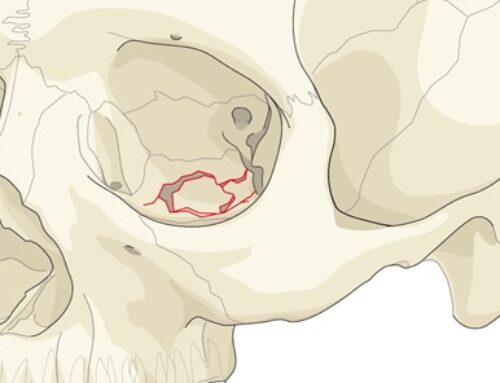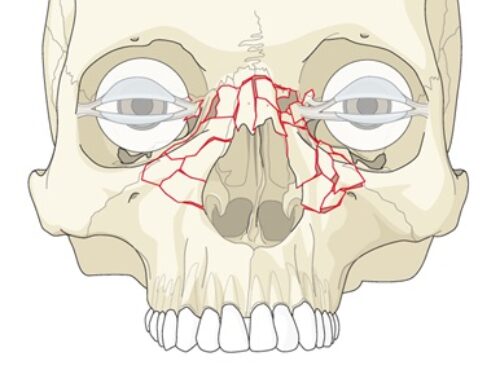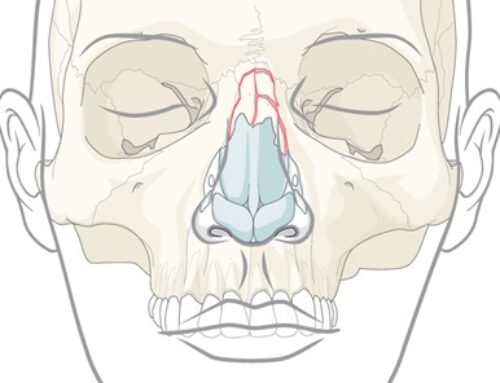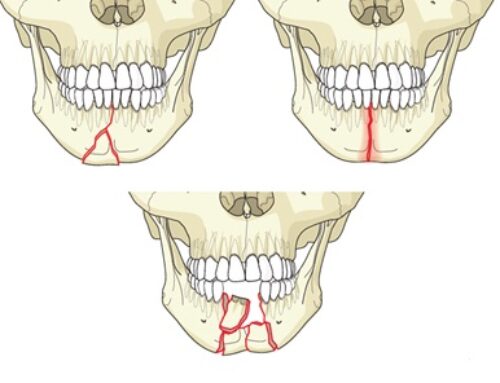Facial Nerve (CN VII)
Branches of Facial Nerve
- Temporal
- Zygomatic
- Buccinator
- Marginal Mandibular
- Cervical
Anatomic Considerations in Temporal Region
Facial Nerve Trunk
- Tympanomastoid suture line is palpable as a hard ridge deep to the cartilaginous portion of the external auditory canal. The facial nerve emerges a few mm deep to its outer edge.
- Tragal pointer: facial nerve lies 1cm deep and inferior to the pointer
- Digastric muscle: during parotidectomy, lateral retraction of the SCM muscle exposes the posterior belly of the digastric. The facial nerve trunk lies 1cm above and parallel to the upper border of the digastric muscle near its insertion at the mastoid tip
Temporal Branch of Facial Nerve
The temporal branches of the facial nerve are often called the frontal branches when they reach the supraciliary region. The nerves provide motor innervation to the frontalis, to the corrugator, to the procerus, and occasionally, to a portion of the orbicularis oculi muscle. Nerve injury is revealed by the inability to raise the eyebrow or wrinkle the forehead.
The temporal branch(es) of the facial nerve leave the parotid gland immediately inferior to the zygomatic arch. It crosses superficial to the zygomatic arch deep to or within the temporoparietal fascia at an average distance of 2cm (range 0.8 cm to 3.5 cm) anterior to the anterior concavity of the external auditory canal.
- Al-Kayat and Bramley performed 56 cadaveric dissections and measured the distance from the anterior concavity of the external auditory canal to the point where the temporal branch of the facial nerve crosses the zygomatic arch. The range was found to 0.8-3-5cm with a mean distance of 20 mm.
Temporal branch of CN VII – lies immediately beneath the temporoparietal fascia above the superficial layer of the temporalis fascia.
Superficial Temporal Artery
- Superficial temporal artery – Terminal branch of external carotid artery. Divides into frontal and parietal branches a few centimeters above the arch. The superficial temporal vein and auriculotemporal nerve are posterior to the superficial temporal artery.
Anatomy of Temporal Region
Layers of Temporoparietal Region
- Skin
- Subcutaneous tissue
- Temporoparietal fascia
- Superficial layer of temporalis fascia
- Temporalis
- Deep layer of temporalis fascia
The temporoparietal fascia is frequently called the superficial temporal fascia or the suprazygomatic SMAS and is an extension of the galea and is continuous with the SMAS of the face. Because the fascia is just beneath the skin, it may go unrecognized after incision. The blood vessels of the scalp, such as the superficial temporal vessels, run along the outer aspect of the fascia, adjacent to the subcutaneous fat. The motor nerves, such as the temporal branch of the facial nerve, run on its deep surface.
The temporalis fascia is the fascia of the temporalis muscle. At the level of the superior orbital rim, the temporalis fascia splits, with the superficial layer attaching to the lateral border and the deep layer attaching to the medial border of the zygomatic arch.
Temporoparietal Fascia
- Most superficial layer beneath the subcutaneous tissue
- AKA superficial temporal fascia, suprazygomatic SMAS
- Lateral extension of the galea and continuous with the SMAS
- Fascia is just beneath the skin and may go unrecognized
- Temporal branch of facial nerve lies deep to the temporoparietal fascia
Temporalis Fascia
- Splits at level of superior orbital rim into superficial and deep layers
- Superficial layer of temporalis fascia – lateral border of zygomatic arch
- Deep layer of temporalis fascia – medial border of zygomatic arch
- Temporal branch of facial nerve lies superficial to the temporoparietal fascia
LeFort Midfacial Fractures
- Le Fort I: fracture line extends from piriform aperture through the lateral maxillary and lateral nasal walls to the posterior region and will often include a segment of pterygoid plates.
- Le Fort II: fracture line extends from the pterygoid region on one side, underneath the zygomaticomaxillary buttress up over the medial portion of the infraorbital rim, behind the lacrimal bone and along the medial wall of the orbit towards the dorsum of the nose where it crosses and proceeds to the opposite side in the same manner. Various amounts of the pterygoid plates will usually remain attached to the posterior maxilla.
- Le Fort III: fracture line begins at the frontozygomatic suture along the lateral aspect of the internal orbit along the sphenozygomatic suture line to the inferior orbital fissure, extends medially across the floor of the orbit up the medial wall of the orbit towards the dorsum of the nose where it crosses and proceeds to the opposite side in the same manner. Various amounts of the pterygoid plates will usually remain attached to the posterior maxilla.
Anatomy of Zygoma
The zyomatico-maxillary complex has 4 articulations.
- Frontal bone
- Maxillary bone
- Sphenoid bone
- Temporal bone
Buttresses of the Zygomaticomaxillary Complex
- Vertical buttresses: zygomatico-maxillary, pterygo-maxillary, naso-maxillary
- Horizontal buttresses: pyriform aperture, maxillary alveolus and palate, orbital rims, base of skull
Reliable Articulation for Successful Reduction
The sphenozygomatic suture area has been previously analyzed and shown to be an area for confirmation of alignment of the zygomatic arch and the zygomatic complex (ZMC). This has also been shown to key point for fixation thru biomechanical studies. The sphenozygomatic suture is a broad area along the greater wing of the sphenoid and can be approached along the internal aspect of the lateral orbit. Even in severe midface fractures the greater wing of the sphenoid is intact thus acting as a key landmark for proper reduction of the ZMC fracture.
Exam & Assessment
- Facial asymmetry
- Periorbital ecchymosis +/- crepitus
- V2 paresthesia
- Lateral canthal dystopia
- Trismus
- Signs of orbital injury
- Ocular exam if orbital floor involved
- Palpate and visualized malar eminence from above for deformity
- Palpate intra-orally for crepitus/deformity of the maxillary buttress region
Signs & Symptoms
- Swelling and flattening of cheek along with periorbital edema/ecchymosis
- Downward displacement of the zygoma, which produces an anti-mongoloid slant to the lateral canthus with accentuation of the supratarsal fold of the upper eyelid
- Subconjunctival hemorrhage
- Step deformity and point tenderness at zygomatic arch, inferior orbital rim, ZF suture, and zygomatic buttress region
- In isolated zygomatic arch fractures, a depression is observed and palpated anterior to the tragus
- Flattening of the malar prominence of the zygomatic arch
- Epistaxis due to involvement of maxillary sinus
- Ecchymosis in maxillary buccal vestibule (Guerin’s sign)
- Trismus due to impingement of coronoid process by collapsed zygoma
- Infraorbital nerve paresthesia due to either direct trauma or impingement from the fractured segments of bone
- If extensive orbital involvement, the possibility for changes in globe position, including evidence of vertical dystopia, enophthalmos, and inferior rectus muscle entrapment
Indications for Treatment of ZMC Fracture
- Facial Aesthetics: reestablish typical contour of the face for a more symmetric look and to prevent complications such as facial dysmorphism, enophthalmos, and orbital dystopia
- Protection: vital absorbent function in the safeguard of the orbit and brain
- Functional Impairment: fractures that interfere with ocular function, infraorbital nerve function, or normal mouth opening should be treated
Classification of ZMC Fractures
Knight and North Classification (1961)
- Group 1: undisplaced fracture, fracture visible on radiograph
- Group 2: isolated arch fractures
- Group 3: unrotated displaced body fractures
- Group 4: medially rotated body fracture
- 4a: outward at malar buttress
- 4b: inward at the FZ suture
- Group 5: laterally rotated body fracture
- 5a: upward at the infraorbital margin
- 5b: outward at the FZ suture
- Group 6: any additional fracture lines across the main fragment
Zingg et al Classification (1992)
- Type A: Incomplete low-energy fracture with fracture of only one zygomatic pillar
- A1: isolated arch; A2: lateral orbital wall; A3: infraorbital rim
- Type B: Complete mono-fragment fracture with displacement along all four articulations
- Type C: Multi-fragmented, comminuted fractures of zygomatic body
Ozyazgan et al Classification (2007)
- Type I: isolated arch fracture, no displacement
- Type II: displacement with bone contact at all fracture lines
- Type III: displacement without bone contact at 1 fracture line
- Type IV: displacement without bone contact at 2 fracture lines
- Type V: comminution or displacement without bone contact at 3 or more fracture lines
Indications for Open Reduction of Condylar Fractures
Absolute Indications
- Inability to obtain adequate occlusion using closed reduction technique
- Displacement of the condyle into the middle cranial fossa
- Severe angulations of the condyle, lateral extracapsular displacement of condyle or the condyle outside the glenoid fossa
- Removal of foreign body in the joint capsule
Relative Indications
- Bilateral condylar fractures with concomitant comminuted midfacial fractures
- Bilateral fractures in an edentulous patient when splints are unavailable or impossible because of severe ridge atrophy
- Displaced condyle fracture in a medically compromised patient (e.g seizure disorder, psychiatric problems, or alcoholism) with evidence of open bite or retrusion
Surgical Approaches
Extra-Oral Approach
- Bicoronal or hemicoronal
- Gilles
- Superiorlateral
- Lateral brow
- Upper eyelid
- Lower eyelid
- Transconjuntival
- Subciliary
- Infraorbital
- Percutaneous
Intra-Oral Approach
- Maxillary vestibular
Coronal Approach
- Incision on the scalp is made through skin, subcutaneous tissue, and galea 4 to 5 cm within the hairline – revealing the subgaleal plan or loose areolar connective tissue overlying the pericranium. Can inject vasoconstrictor into subgaleal plane to promote hemostasis and to help separate the tissue layers.
- After elevation of the anterior and posterior wound margins, hemostatic clips (Raney clips) may be applied.
- Subgaleal dissection is carried anteriorly until a point 3 to 4 cm superior to the supraorbital rims. A horizontal incision is made through the pericranium from one superior temporal line to the next.
- Depending on amount of exposure required, coronal incision can be carried inferiorly to the helix (if exposure of zygomatic arch is not necessary) or to the level of the earlobe as a preauricular incision (allows exposure of zygomatic arch, temporomandibular joint, and infraorbital rims)
- Skin incision below the superior temporal lines should extend to the depth of the superficial layer of the temporalis fascia.
- Once the lateral portion of the flap has been elevated to within 2 to 4 cm of the body of the zygoma, the flap is dissected inferiorly to the root of the zygomatic arch.
- Incision of the superficial layer of temporalis fascia is made anteriorly and superiorly at a 45⁰ angle, joining the cross-forehead incision made at the pericranium at the superior temporal lines.
- Dissection is carried down to the zygoma and periosteum is incised sharply over zygomatic arch.
- It may be necessary to release the supraorbital neurovascular bundle from its notch or foramen by using a osteotome to remove the bon bridge along the supraorbital rim
- The medial canthal tendons should not be inadvertently stripped. The anterior and posterior ethmoid arteries can be cauterize. With a periosteal on each side of the foramen, retraction allows the periosteum attached to the foramen to tent outward to allow for cauterization of the vessels.
Approaches to Zygomatic Arch
| Gilles | Keen | Carmedy-Baxon |
| Extra-oral | Trans-oral | Trans-oral |
| 2.5cm superior and anterior to helix | Buccal sulcus (vestibule) | Lateral coronoid (along ascending ramus) |
| Indirect access to zygomatic arch | Access to infraorbital rim and nasomaxillary region | Limited exposure |
Temporal Approach (Gillies)
- 2cm incision is made 2.5cm superior and anterior to the helix, within the hairline
- Dissection carried through subcutaneous tissue and temporoparietal fascia down to the glistening white superficial temporalis fascia
- Deep temporal fascia is incised to expose the temporalis muscle
- A Rowe elevator is inserted deep to the superficial temporalis fascia and superficial to the temporalis muscle and the arch is elevated in an outward and forward direction
- *Care should be taken not to put force on the temporal bone as this might cause pressure necrosis of the temporalis muscle
- * Temporal branch of facial nerve is deep to temporoparietal fascia and superficial to superficial layer of temporalis fascia
Transoral Approach (Keen)
- 2cm incision made through mucosa only intraorally inferior to the ZM buttress
- Blunt tipped elevator guided under the arch, and arch manipulated upward, outward and anteriorly.













